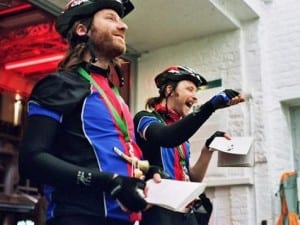“Lone Twin negotiate not only their relationship with each other but also, more importantly, their relation with other people.” ((Williams, David and Carl Lavery (2011) Good Luck Everybody: Lone Twin: Journeys, Performances, Conversations, Wales: Cambrian Printers, p.69))
 |
The audience and the performer have very different roles. In theatre the audience come to watch a performance and to be entertained in a friendly and safe environment. In site specific performance, the roles are the same, yet the environment will be different depending on the chosen site. ‘Safe House’ is in an interesting site to perform in, and isn’t the most welcoming house to invite the audience into. They won’t know what to expect and they will be interacting with the performers which generally in theatre, wouldn’t happen. “Rather than simply occupying an ‘ususual setting’, site-specific performance is adjudged to hold ‘possibilities for responding to and interrogating a range of current spatial concerns..” ((Pearson, Mike (2010) Site-Specific Performance, UK: Palgrave Macmillan, p.8))
Although our audience is coming to watch a performance, the idea of them being watched will be present as they will notice and be aware that there are CCTV cameras in each room. This questions who is doing the watching and who is being watched; the audience or the performer.
“Here the term ‘house’ is to be understood in a general sense as any closed individual area beyond the body, in which man can remain and move with safety.” ((Bollnow, O.F. (2011) Human Space, London: Hyphen Press, p.267)) Thinking about this, I have decided to experiment with this whole concept in my performance in the kitchen. I would like the audiences experience in the kitchen to be different from any other room in the house, and to go away with different reactions to it. Perhaps trying various performances on my audience will create a whole new reaction, one performance idea being me watching my audience.
Having a television playing a film of the adventures I have had as a rabbit is quite humorous, and will draw the audience in. But perhaps instead of interacting with my audience, I could just ignore them. Standing quietly in the corner gives a different feel to the room completely, as it contrasts to the humour and makes them aware that they are the ones being watched. Me watching them watching me on the television is particularly interesting, and will be fascinating to see the reactions I then get from them.
“if you dress up funny…people will shout at you” ((Govan, Emma, Helen Nicholson and Katie Normington (2007) Making a Performance, Devising Histories and Contemporary Practices, London: Routledge, p.125))
Another performance technique I could experiment with is discussing with the audience the reactions I have received, using what people have said as verbatim to tell others: “Moreover, in some examples of verbatim theatre the performers also incorporate elements of their own lives into the production, employing a self-reflective mode.” ((Haedicke, Susan (2009) Political Performances: Theory and Practice, New York: Columbia University, p.115))
Having filmed in different places in the bunny costumes I have met different people with a variety of reactions to me. Whatever reaction I get will be written down or recorded, and this can be used as conversation in my performance. This will create a different reaction all together from the previous performance idea as I will be verbally interacting with my audience in the bunny costume, which again brings humour and absurdity to be having a civilized conversation in a kitchen with a giant rabbit.
Lone Twins, ‘To The Dogs’, is a good example of a piece of their work that gradually built and expanded as it was carried out. Gregg and Gary cycled two folding bicycles through Brussels, Belgium for 24 days and ended each day by putting on a short performance at the Kunsten Festival des Arts retelling the events of that day. The experiences they had built up over this period of time and each performance expanded as they experienced more things, interacted with more people and witnessed various different places: “The interest is in how those small moments, each five minutes long, will change over time as they become situated in the growing, differing contexts of each other.” ((Williams, David and Carl Lavery (2011) Good Luck Everybody: Lone Twin: Journeys, Performances, Conversations, Wales: Cambrian Printers, p.69))